![]()
![]()
![]()
Use LEFT and RIGHT arrow keys to navigate between flashcards;
Use UP and DOWN arrow keys to flip the card;
H to show hint;
A reads text to speech;
34 Cards in this Set
- Front
- Back
- 3rd side (hint)
|
Thermionic emission |
Term used to describe when electrons are “boiled off” Cathode wires. Either large FSS or small FSS (focal spot size) |
|
|
|
What happens when mA is applied (milliampere) |
Wire gets super hot and “boils off” electrons. (Termionic emission) |
|
|
|
What does mA control |
Quantity, density |
|
|
|
What is kV |
Kilovoltage. Is the final force pushing the electrons to reach the anode. Negatively charged electrons aren’t strong enough to reach positive anode by themselves. So when kV is applied it pushed electrons to reach anode and create X- Rays. The more kV applied the stronger the rays become and you get more penetrating power which results in better quality images with more density and contrast between black/white. |
|
|
|
What does kV (kilovoltage) mainly affect. |
Quality. |
|
|
|
Time (s) |
Is like mA. Controls quantity because the longer the exposure the more rays are produced. Controls density also like mA |
|
|
|
mAs. |
Milliampere seconds. Combines mA and seconds since they are practically the same. Use low mAs for things like fingers, wrist, foot, hand,etc. Use high mAs for things like abdomen or hips. Bigger body parts mAs is like the paint analogy. You need more mAs (paint) for bigger parts. |
|
|
|
Useful ray |
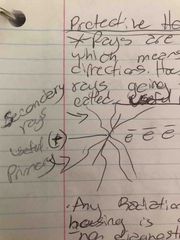
The rays that’s actually get used up during procedure. Rays which actually point to object. |
|
|
|
Secondary rays |
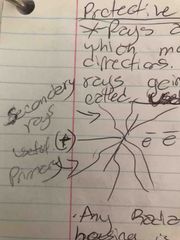
Rays which do not get used or do not hit object. |
|
|
|
Ceiling x-ray machine. |
Most common. Freely moves in all directions: transverse, longitudinal, up and down. Nearly limitless |
|
|
|
Floor to ceiling x-ray machine |
Has limitations on movement. Requires more effort to move but cheaper. |
|
|
|
Floor to ceiling x-ray machine |
Has limitations on movement. Requires more effort to move but cheaper. |
|
|
|
C arm X-ray machine |
Nearly limitless in tube positions. Robotic and fluid in motion. Angiography Ability to provide fluoroscopy. (Live radiation) |
|
|
|
IP |
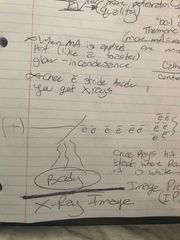
Image plate? Once raya hit IP it turns black where rays didn’t hit anything. And white where X-ray’s hit bone. |
|
|
|
Protective housing |
Housing helps you only use rays going towards patient. Lead lines to reduce leakage radiation. Protects from rough handling. Contains oil to dissipate heat and insulate from shock |
|
|
|
Protective housing |
Housing helps you only use rays going towards patient. Lead lines to reduce leakage radiation. Protects from rough handling. Contains oil to dissipate heat and insulate from shock |
|
|
|
What is isotropic. |
Rays are produced isotropically. Which means they go in all different directions. That’s why the protective housing is useful. |
|
|
|
Leakage radiation. |
Any radiation that escaped protective housing. No diagnostic and harmful to patient and technologist. |
|
|
|
Leakage radiation. |
Any radiation that escaped protective housing. No diagnostic and harmful to patient and technologist. |
|
|
|
How much does lead-lined protective housing help |
<100 mR/hr @ 1 meter |
|
|
|
How many of the electrons get turned into X-ray. |
1%. The other 99% gets turned to heat. |
|
|
|
glass envelope |
Made of Pyrex glass Vacuumed to prevent any air molecules from blocking the path of electrons. Leads to more efficient X-ray productions and longer tube life. |
|
|
|
Cathode. |
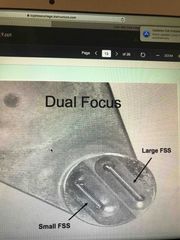
Negative electrode. Filament: 2 coils of wire composed of tungsten for greater efficiency. Vaporized tungsten is the leading cause of tube failure. “Thermionic emission “ Dual focus. Large FSS small FSS. Focal spot size. |
|
|
|
FSS |

Focal spot size. Small and large. Small FSS shows better detail because it focuses the rays in one spot. 200 mA or less Large FSS is better for bigger body part. Can also withstand more heat. 300mA or more |
|
|
|
Focusing cup |
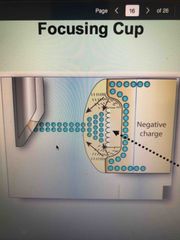
Area surrounding wire Divet (imbedded) Negative charge greater than sum of electrons together keeps electrons tight |
|
|
|
Space charge |
Prevents subsequent electrons from being boiled off (thermionic emission) due due electric repulsion (same charges repel |
|
|
|
Anode |
Positive electrode Stationary or rotating |
|
|
|
Anode |
Positive electrode Stationary or rotating Area of impact with electrons is called tungsten target. Contains copper which is good at dissipating heat |
|
|
|
Stationary anode |
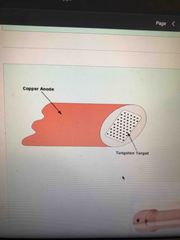
X-ray’s hitting the same spot create a pitting. Not good for high intensity X-rays. Dental and portable X-ray units |
|
|
|
Rotating anode. |
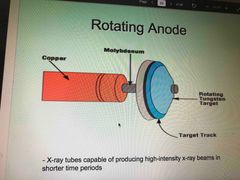
Spinning motion allows target to cool down between X-rays and won’t create a divet. Good for high intensity X-rays. Has 2 target tracks. One for small FSS and other for large FSS |
|
|
|
Anode |
Positive electrode Stationary or rotating Area of impact with electrons is called tungsten target. Contains copper which is good at dissipating heat |
|
|
|
Stationary anode |
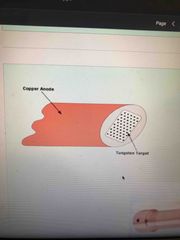
X-ray’s hitting the same spot create a pitting. Not good for high intensity X-rays. Dental and portable X-ray units |
|
|
|
Rotating anode. |
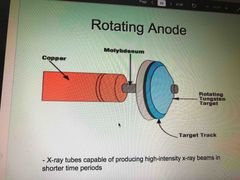
Spinning motion allows target to cool down between X-rays and won’t create a divet. Good for high intensity X-rays. Has 2 target tracks. One for small FSS and other for large FSS 3600 to 10,000 RPM Disc composed of 3 layers- tungsten/rhenium, molybdenum and graphite. |
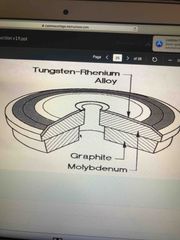
|
|
|
Tungsten |
High atomic number (#74) Thermal conductivity. Better at heat dissipation High melting point. 3410° C (6170° F) Minimize occurrences of pitting |
|

